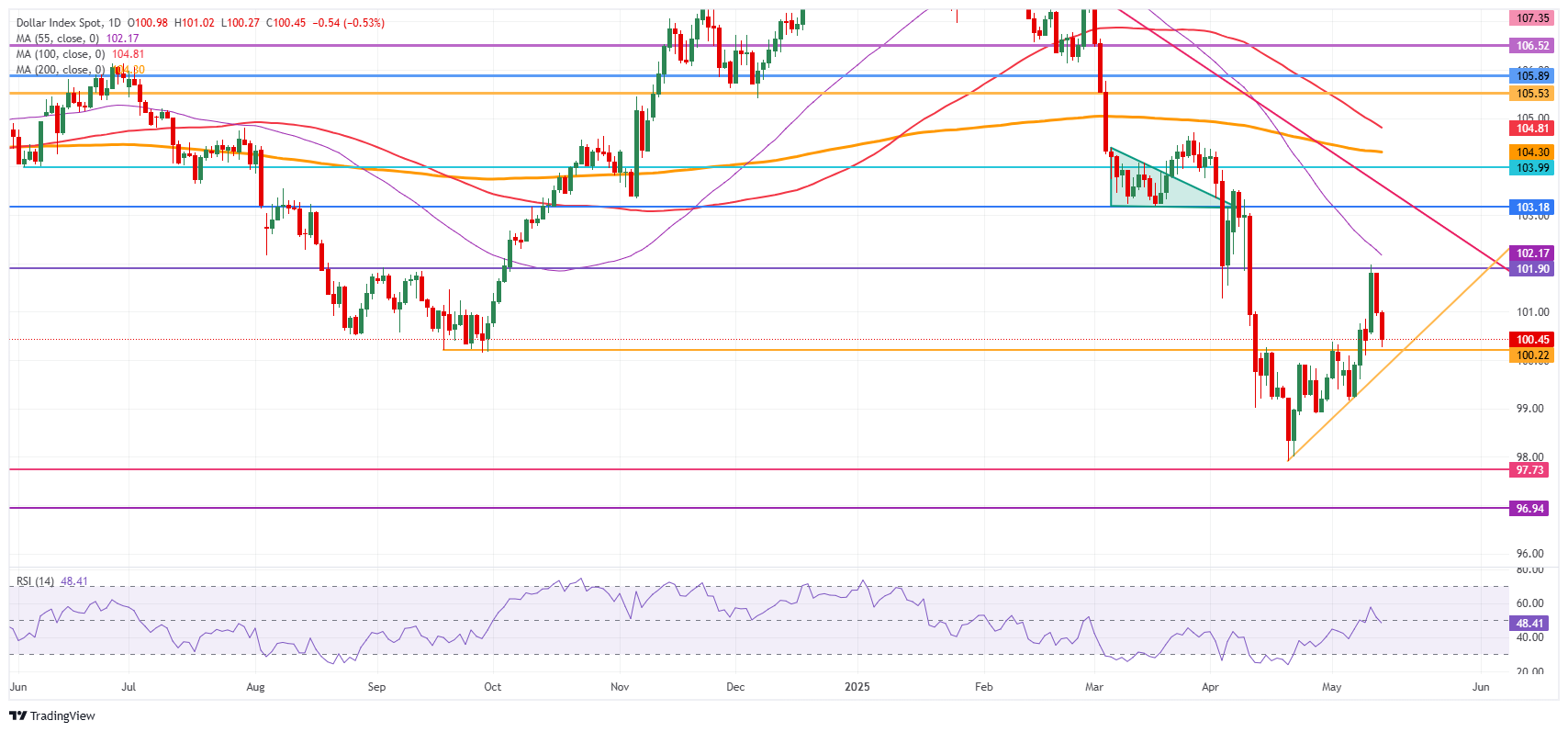US Dollar extends losses for second consecutive day after inflation miss, Forex talks with Korea
- The US Dollar trades on the backfoot on Wednesday for a second consecutive day after softer-than-expected US inflation data.
- The Korean Won strengthened against the Greenback after the announcement that both countries have discussed Forex markets.
- The US Dollar Index nosedives to test the 100-level.
The US Dollar Index (DXY), which tracks the performance of the US Dollar (USD) against six major currencies, is adding to its losses and dives toward the 100-marker on Wednesday. The move comes after softer-than-expected inflation in the US and the confirmation that the United States (US) and South Korea have been in talks about currencies, according to Bloomberg.
The news opened up not-so-old wounds from earlier this month, when the Taiwan Dollar (TWD) appreciated sharply against the US Dollar. In addition, the soft Consumer Price Index (CPI) reading for April released on Tuesday has revamped rate cut bets for the Federal Reserve (Fed) this year, seeing the probability for a rate cut grow bigger compared to last week. This narrows the rate differential between the US and other countries and devalues the Greenback a touch.
Daily digest market movers: A very light calendar ahead on Wednesday
- Only two Fed speakers for this Wednesday:
- Near 13:10 GMT, Vice Chair Philip Jefferson is set to speak.
- Near 21:40 GMT, Federal Reserve Bank of San Francisco President Mary Daly participates in a fireside chat at the California Bankers Association's 2025 Annual Conference & Directors Forum.
- Equities are not in a good mood this Wednesday, with losses near 0.5% in Europe and US futures also bearing minor losses ahead of the opening bell.
- The CME FedWatch tool shows the chance of an interest rate cut by the Federal Reserve in June’s meeting at just 8.2%. Further ahead, the July 30 decision sees odds for rates being lower than current levels at 38.6%.
- The US 10-year yields trade around 4.45%, steady as traders mull Tuesday’s inflation numbers and rate cut bets for 2025.
US Dollar Index Technical Analysis: Not again!?
A headline on possible currency adjustments appears to be enough to set off some devaluation for the Greenback. The fact that South Korea and the US have been in talks is enough to scaremonger markets in anticipation of the actual event happening. Should more headlines be revealed on the matter, or the actual intervention from the Bank of Korea (BoK) take place, expect to see possibly a revisit of the DXY to the multi-year low at 94.56.
On the upside, 101.90 is the first big resistance again as it already acted as a pivotal level throughout December 2023 and as a base for the inverted head-and-shoulders (H&S) formation during the summer of 2024. In case Dollar bulls push the DXY even higher, the 55-day Simple Moving Average (SMA) at 102.29 comes into play.
On the other hand, the previous resistance at 100.22 is acting as firm support, followed by 97.73, near the low of 2025. Further below, a relatively thin technical support comes in at 96.94 before looking at the lower levels of this new price range. These would be at 95.25 and 94.56, meaning fresh lows not seen since 2022.

US Dollar Index: Daily Chart
US-China Trade War FAQs
Generally speaking, a trade war is an economic conflict between two or more countries due to extreme protectionism on one end. It implies the creation of trade barriers, such as tariffs, which result in counter-barriers, escalating import costs, and hence the cost of living.
An economic conflict between the United States (US) and China began early in 2018, when President Donald Trump set trade barriers on China, claiming unfair commercial practices and intellectual property theft from the Asian giant. China took retaliatory action, imposing tariffs on multiple US goods, such as automobiles and soybeans. Tensions escalated until the two countries signed the US-China Phase One trade deal in January 2020. The agreement required structural reforms and other changes to China’s economic and trade regime and pretended to restore stability and trust between the two nations. However, the Coronavirus pandemic took the focus out of the conflict. Yet, it is worth mentioning that President Joe Biden, who took office after Trump, kept tariffs in place and even added some additional levies.
The return of Donald Trump to the White House as the 47th US President has sparked a fresh wave of tensions between the two countries. During the 2024 election campaign, Trump pledged to impose 60% tariffs on China once he returned to office, which he did on January 20, 2025. With Trump back, the US-China trade war is meant to resume where it was left, with tit-for-tat policies affecting the global economic landscape amid disruptions in global supply chains, resulting in a reduction in spending, particularly investment, and directly feeding into the Consumer Price Index inflation.

